Bruges
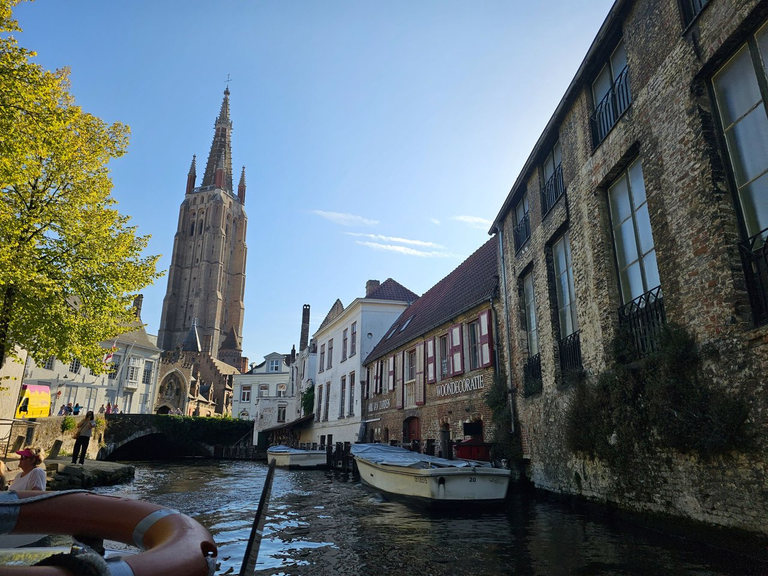
English °
Deutsch °

I've written about Bruges before.
When we were there last summer, we took a boat trip on the second day to get our bearings in the city.
Bruges is also known as the "Venice of the North". As someone from Augsburg, I'm a little dubious about that. Even though this city has a lot of bridges, I couldn't find out exactly how many there are. My city, Augsburg, is also called the "Venice of the North". We have 530 bridges. Hamburg has 2500 bridges, making it the city with the most bridges in Europe. Venice, on the other hand, only has around 400.
Of course, this says nothing about the beauty of the bridges. There is no doubt that Bruges has some very beautiful old bridges.
The river that flows through Bruges is called the Reie and the canals that flow through Bruges are derived from it.
The boat trips are regulated by the city and cost about the same everywhere.
You pay 12 euros per person for about 35 minutes. If I compare that to a ride at the Oktoberfest, it's a bargain. There, a 40-second ride costs around 10 to 14 euros.
The boats are almost always the same. Small electric boats with room for about 26 people.
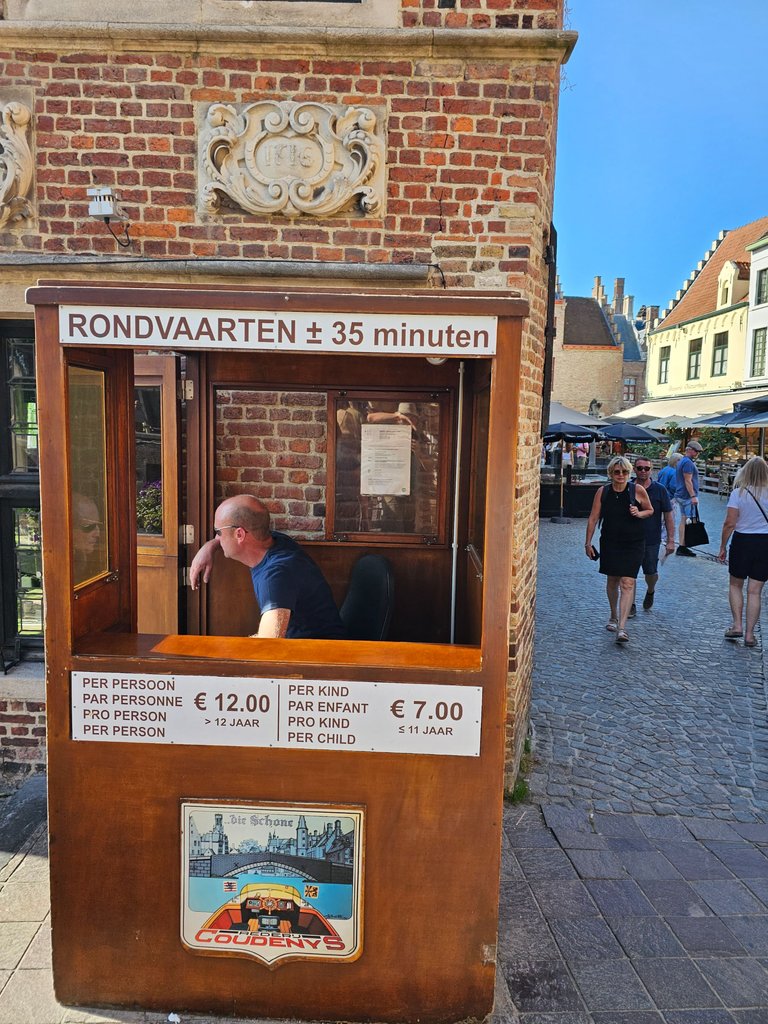
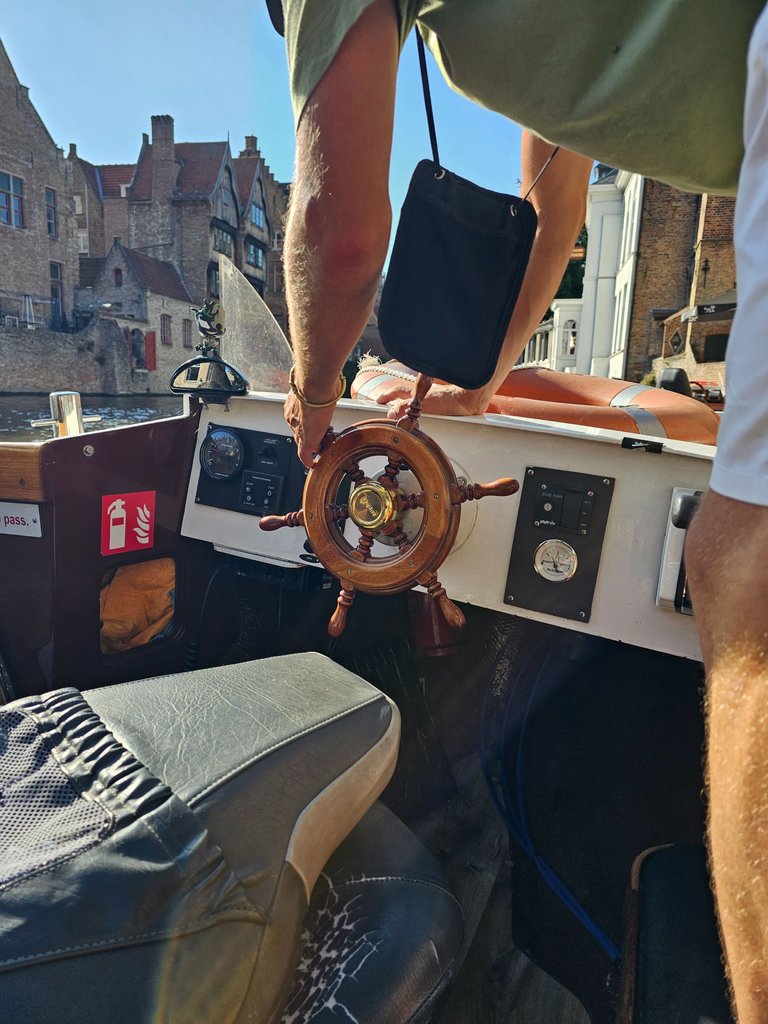
As long as you haven't set off yet, you can take a look at what's in store for you.
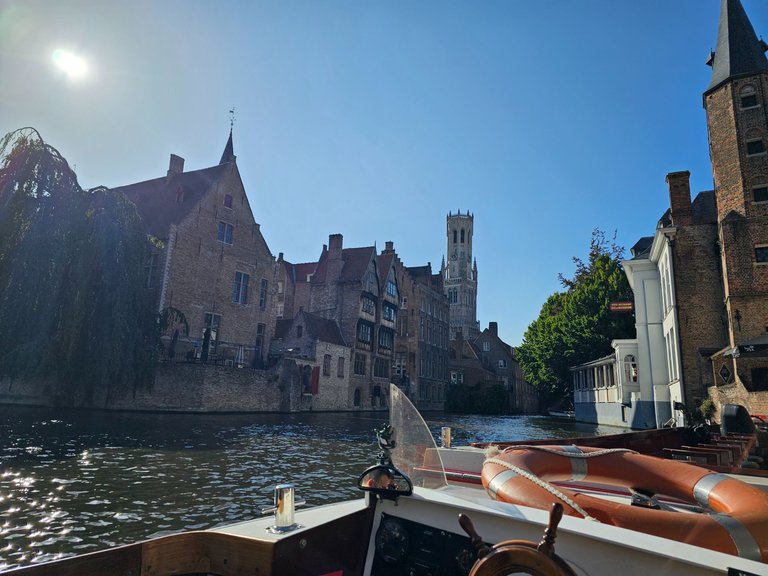
We were really lucky with the weather that day. There were no clouds to be seen and it was a pleasant 25 degrees. The best thing that can happen to you in late summer.
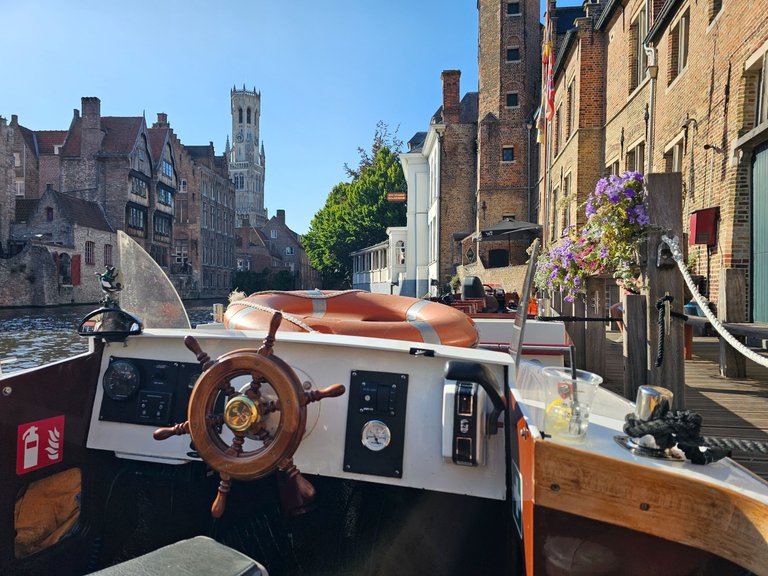
On the right you can see an unfilled boat. This is roughly what they all looked like.
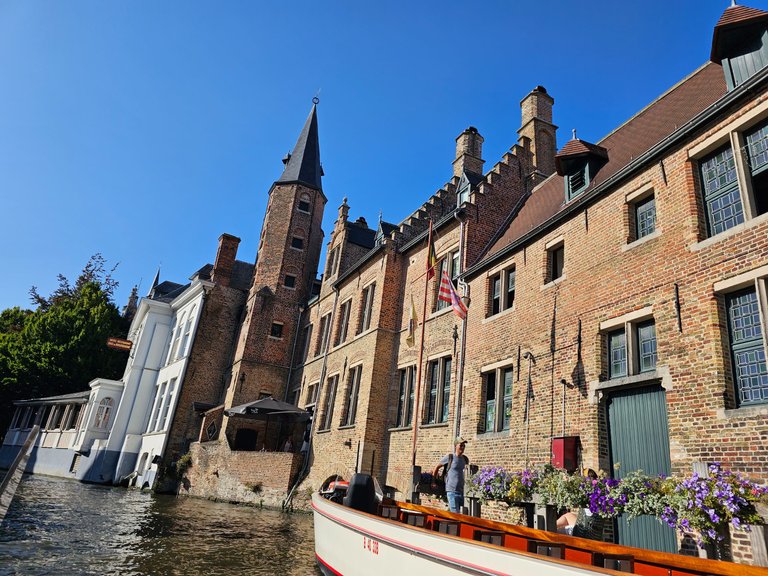

We had a very easy-going skipper. I had to laugh out loud several times during the trip. But I think he makes the same jokes with everyone. But it didn't feel trite with him. If I imagined that I had to sail tourists through the canals all day and probably always have to answer the same comments, I wouldn't have been in such a good mood. But maybe there was a bit more in the can of Coke he was drinking than just Coke.
In any case, that was our captain in the picture below.
On most of the other boats, it was almost exclusively older skippers in full uniform who were at the helm. I was quite happy that we were a bit more relaxed.
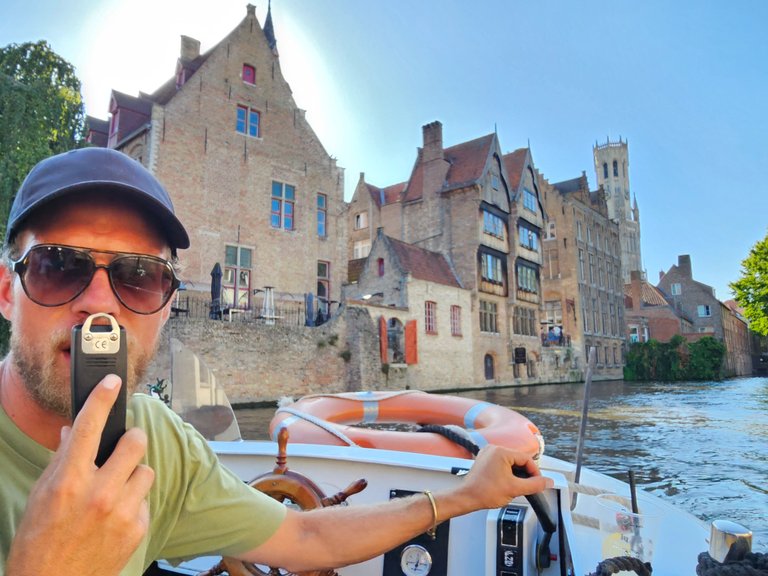
You get the impression that the houses here don't expect high water. It's probably well secured.
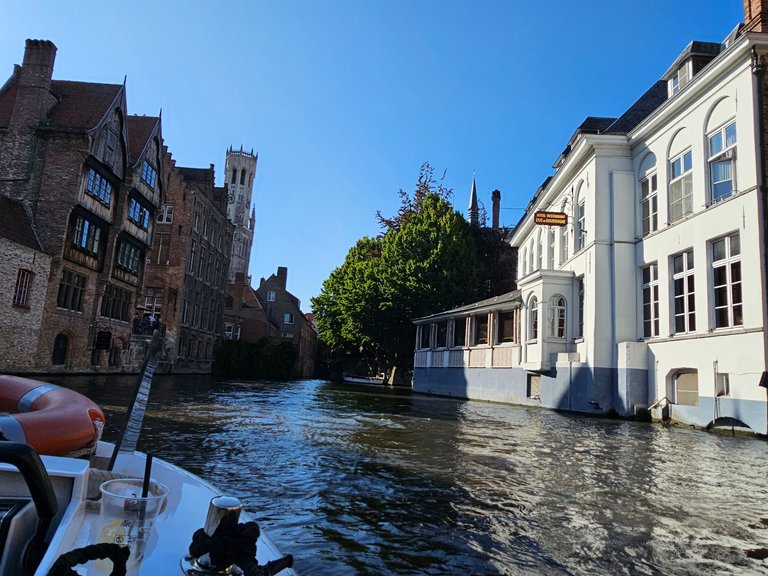
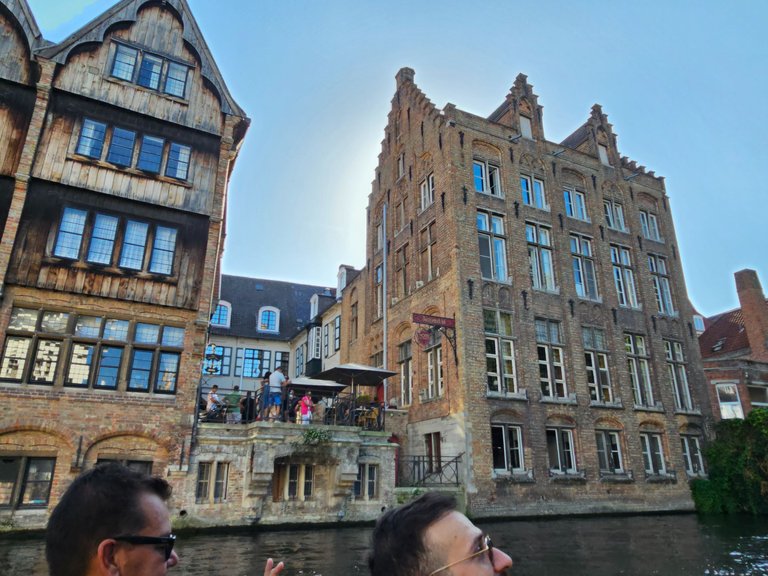
You can never actually get to any restaurants from the canals. They are always accessed from the street. Nevertheless, there are always signs to be seen. I think this is simply because almost every tourist passes through here once on a raft and wants to remember the next stop after the tour. So a sign pointing to a restaurant is an advantage.
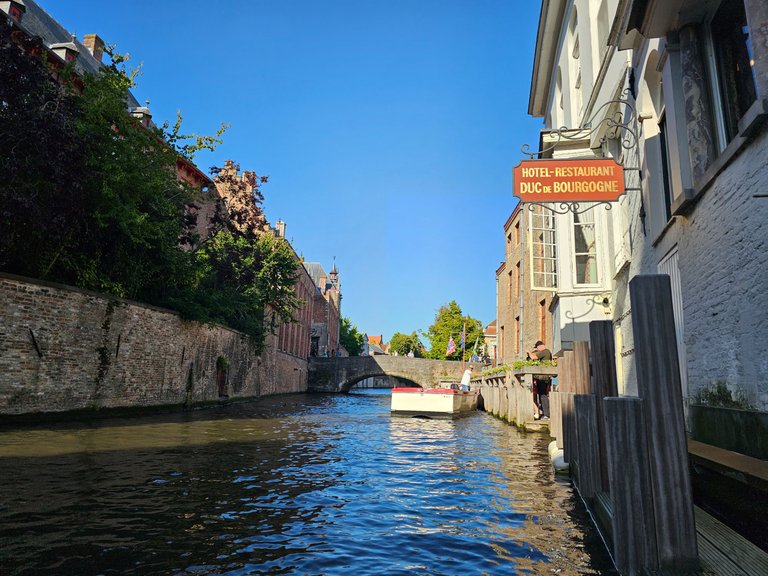
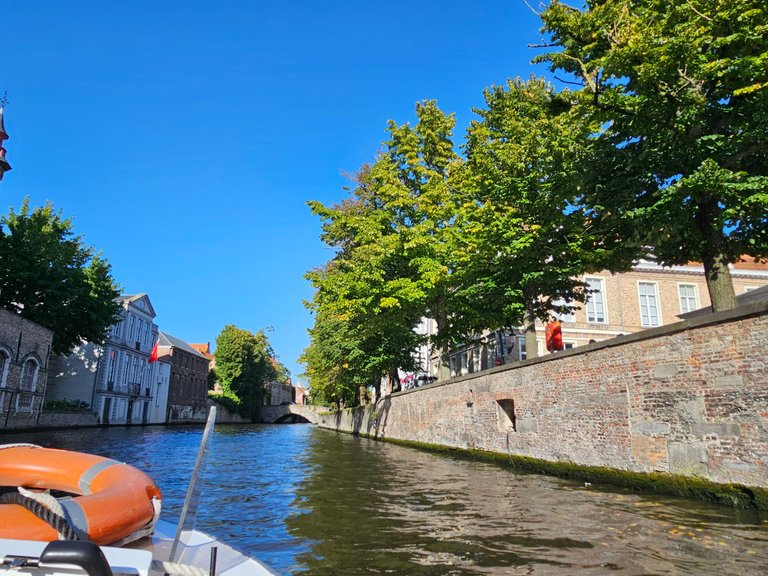
In any case, you soon realize that the bridges are almost always made of stone.
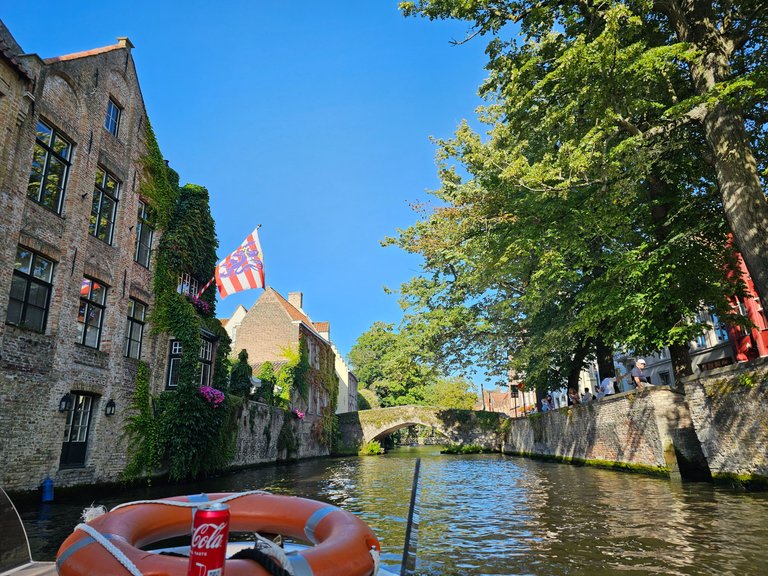
The picture below clearly shows how almost all the houses in Bruges are built. Clinker brick facades are probably the norm here.
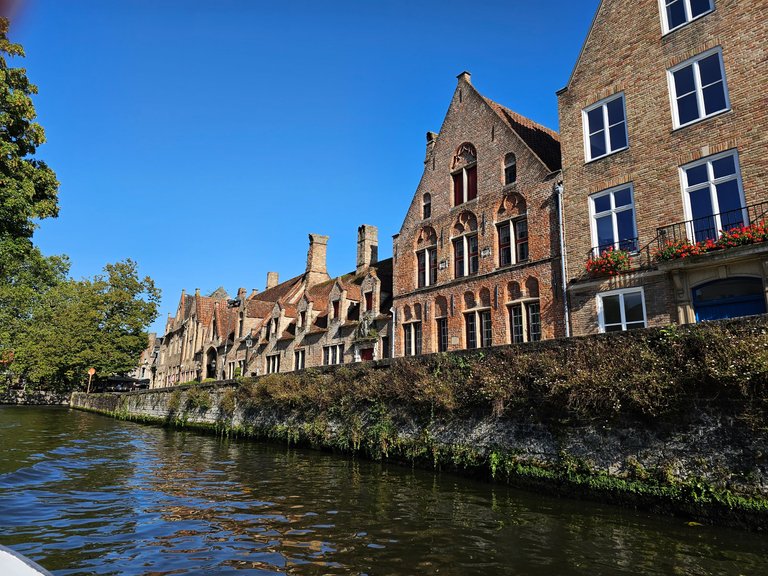
This part of the waterfront is dedicated to gastronomy. Here you will find one restaurant after another. We just walked through, as we always try to avoid the tourist restaurants if we can.
A glance at the menu proved us right.
Pasta with sauce for 25 euros is quite something.

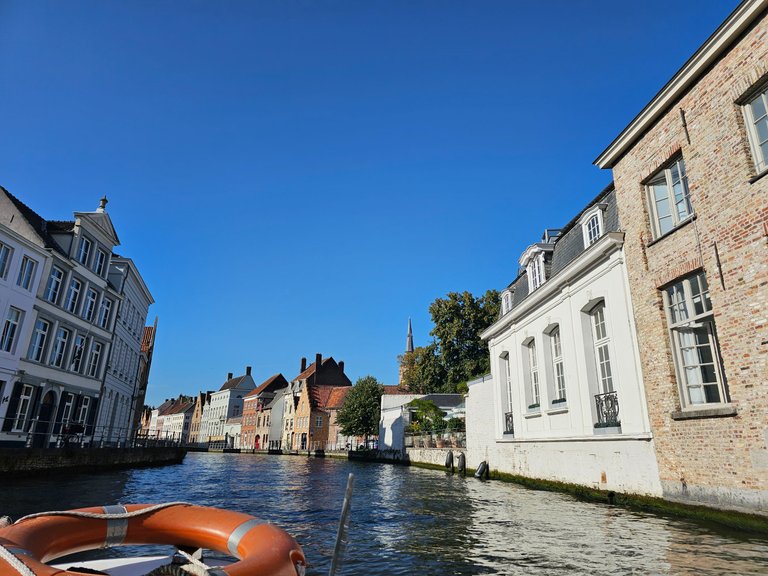
How beautiful these rows of houses look from the water. An iron bay window like the one in this picture is almost distracting.
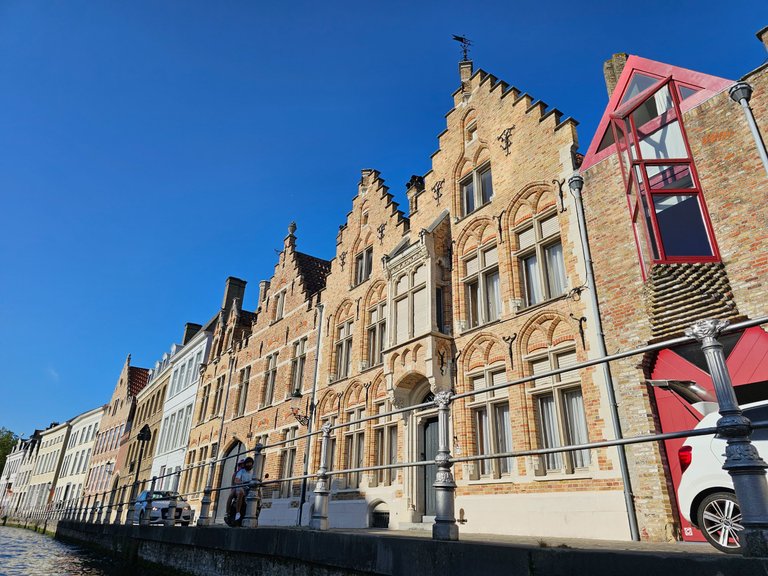
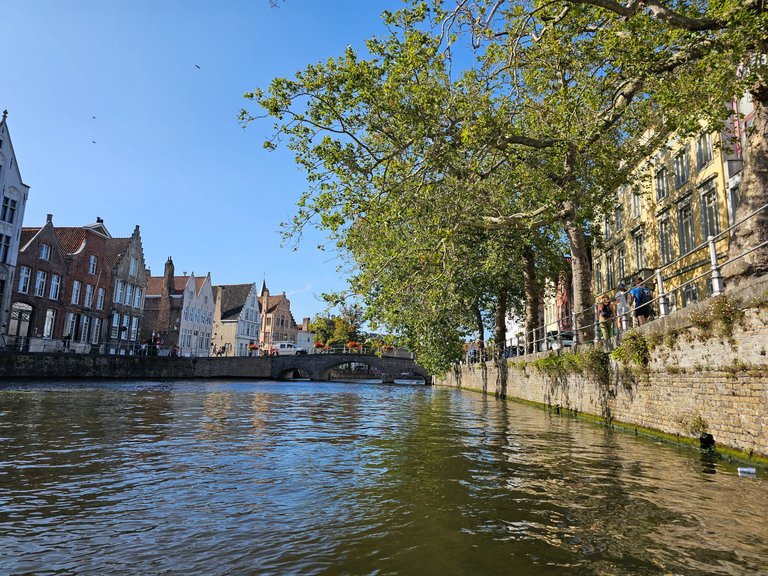
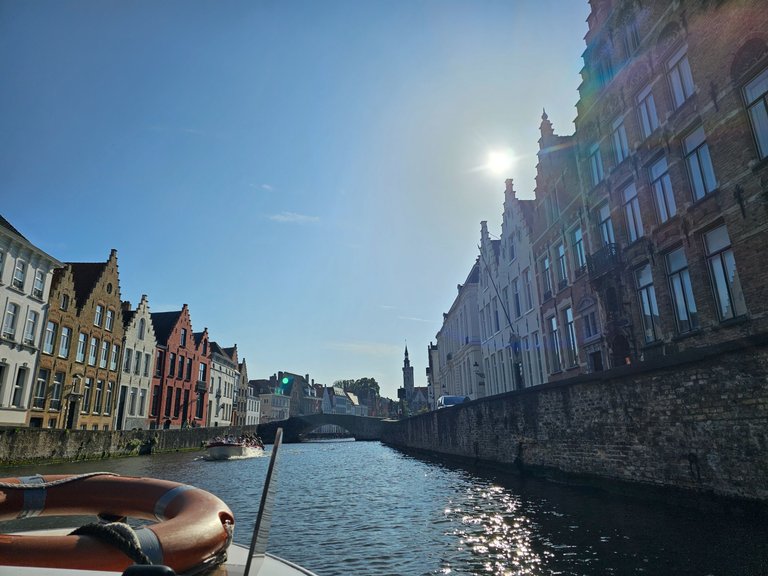
In this small branch of the canal you can see the Poortersloge. One of the many chapels in Bruges.

This bridge is called Meebrug.
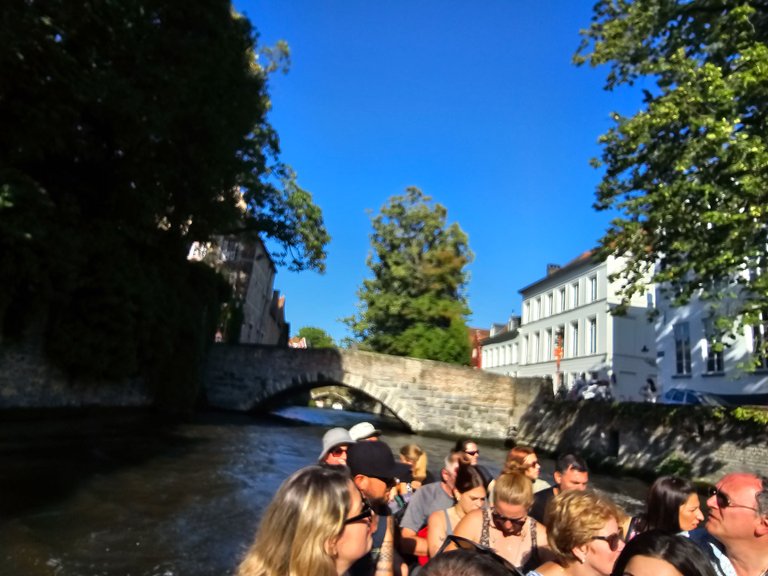

Of course, the skippers also advertise the pubs in the city. This here is the Bourgogne des Flandres. A pub with a brewery. I think many people on the boats go to one of the advertised pubs afterwards.
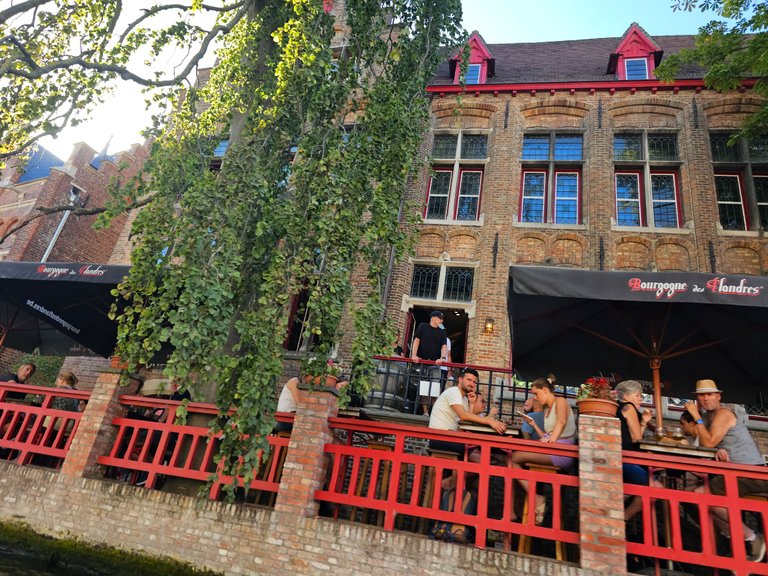

The Church of Our Lady is famous for the art on display in the church.
Among other things, the Bruges Madonna by Michelangelo is on display here. Unfortunately we could not see it.
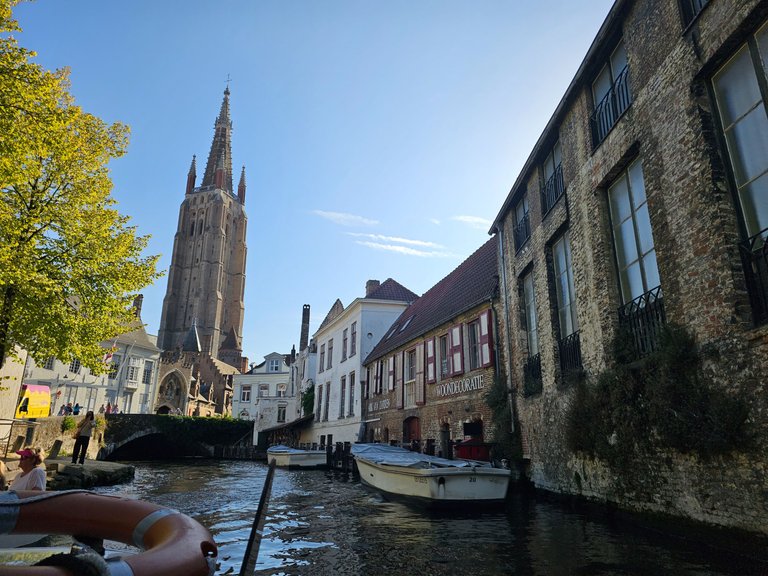
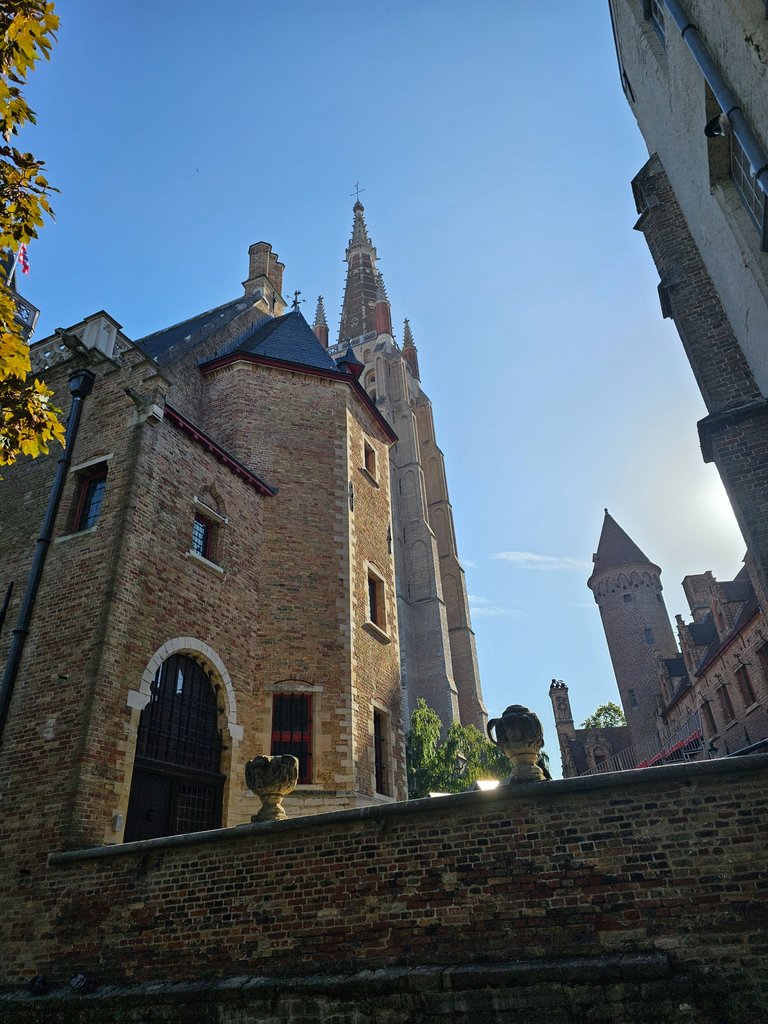
This here is the Bonifacius Bridge. It actually looks like any other here.
It's in almost every guidebook about Bruges.
It's probably one of the youngest bridges here, but also one of the most romantic. At least that's what they say. We couldn't really see why it should be more romantic than the others. But it is certainly beautiful.
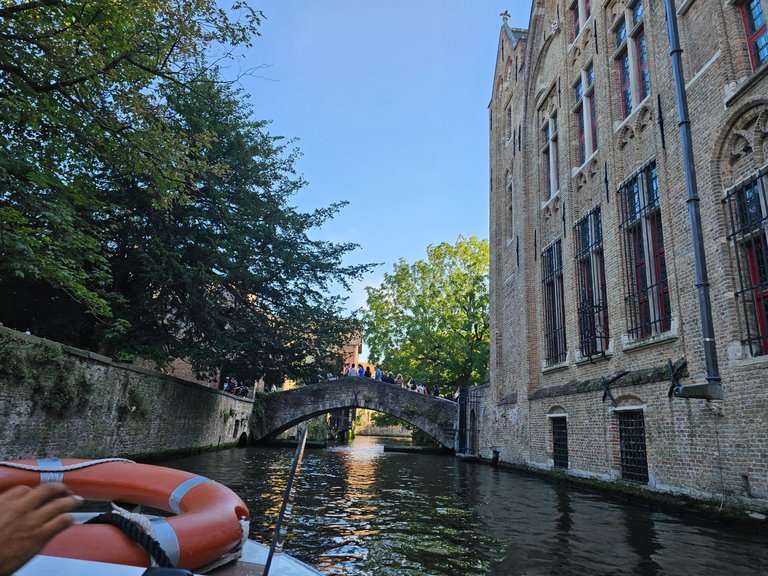
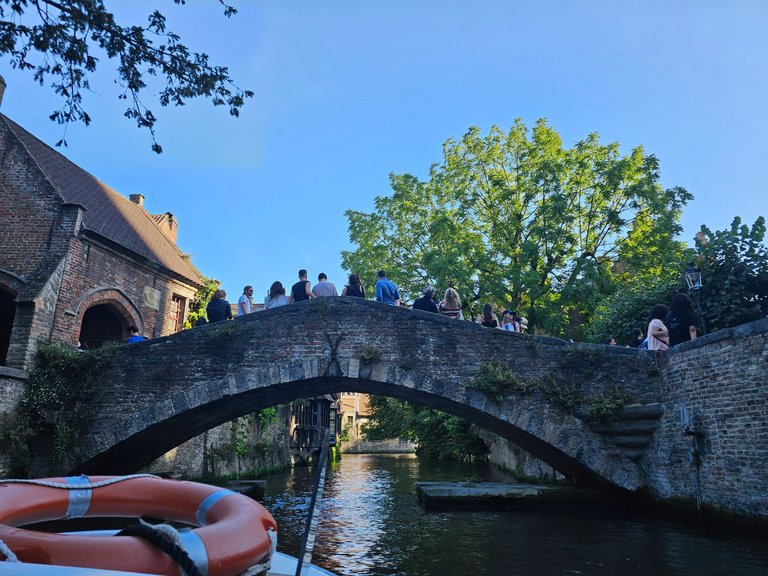
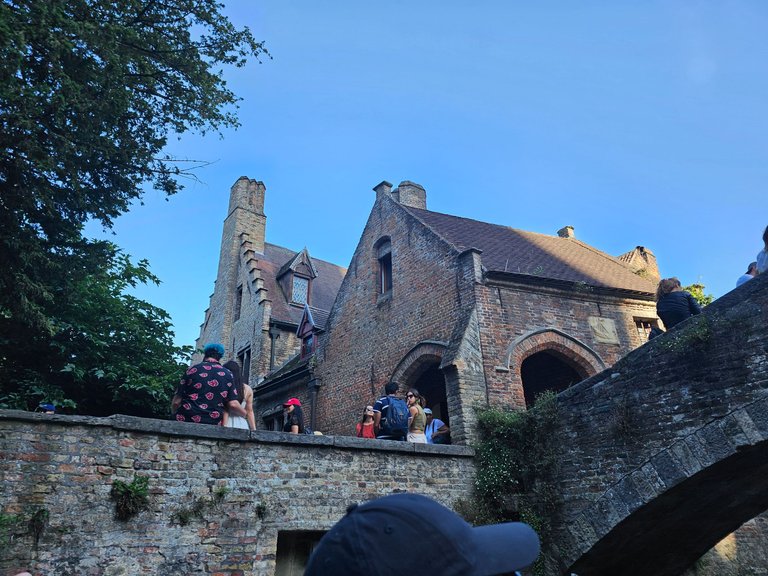
This is probably the most beautiful part of the journey by boat. You almost feel like you're in the Middle Ages.

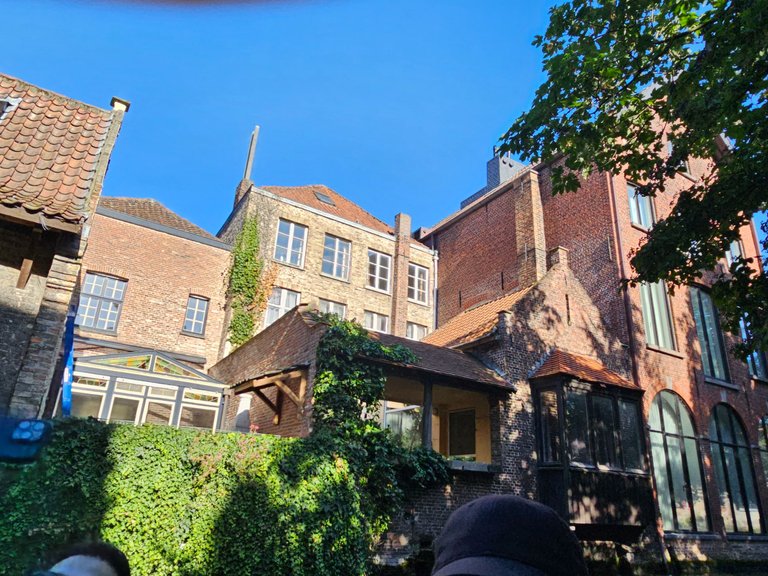
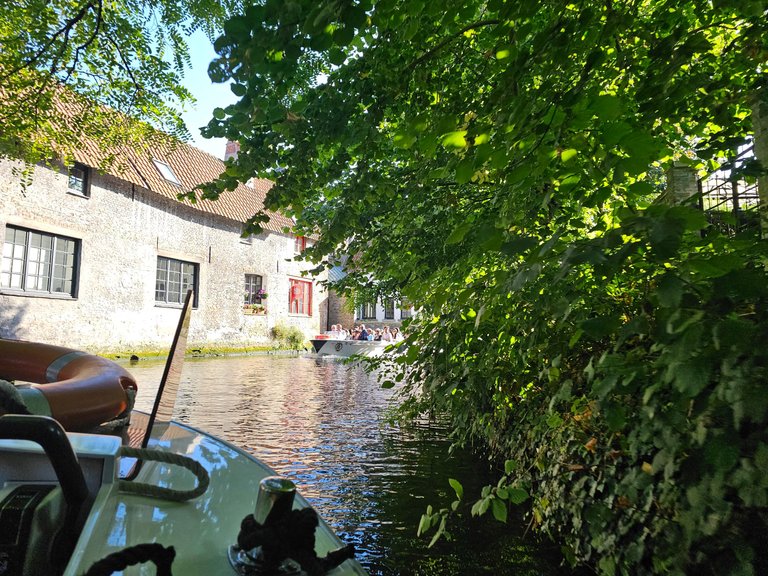
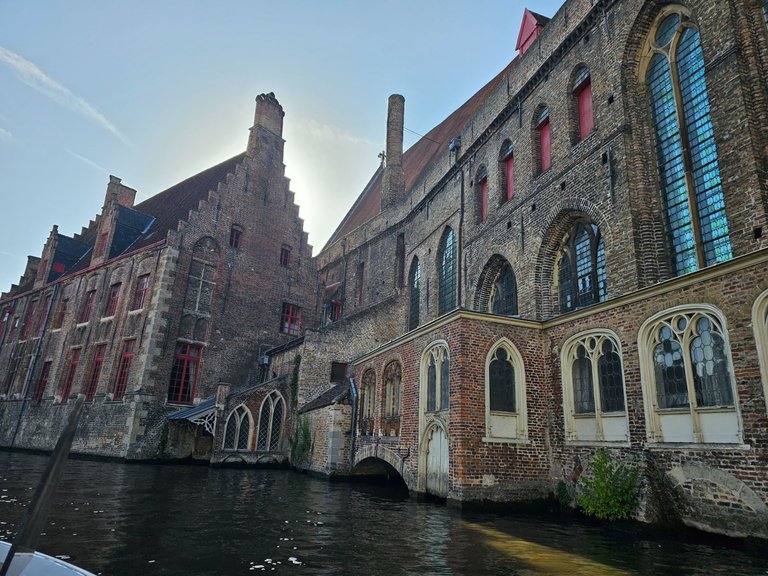
Suddenly a kind of small lake appeared here. It is Sint Janskaai. There was also a restaurant with tables outside. Certainly a nice place, but we didn't visit it due to lack of time.
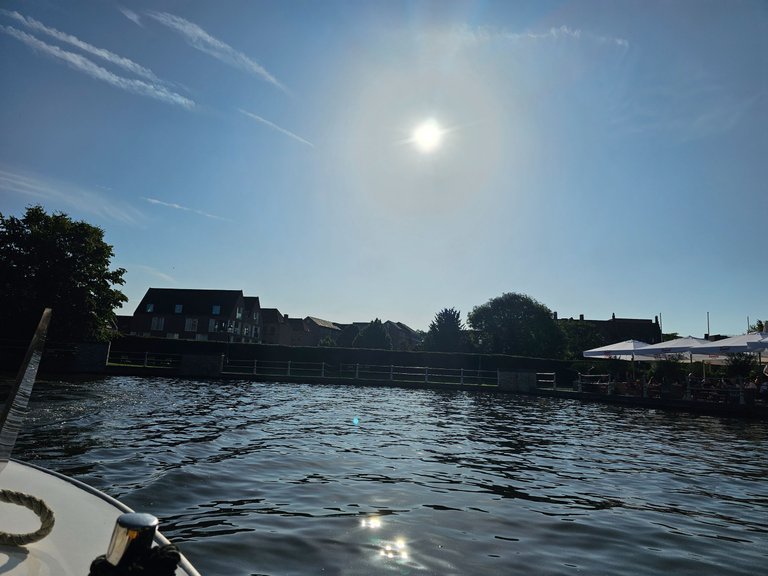
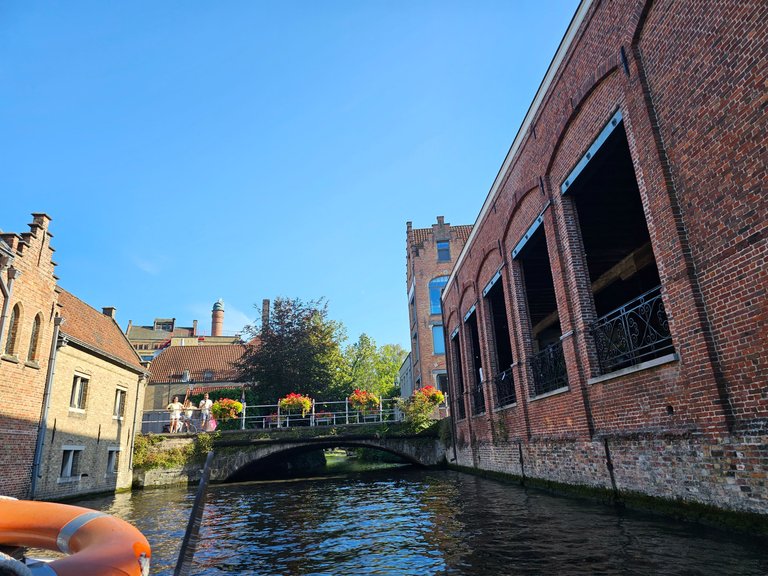
You could tell that there was suddenly more greenery on the shore. It felt a bit like driving slowly out of the inner core of the city.
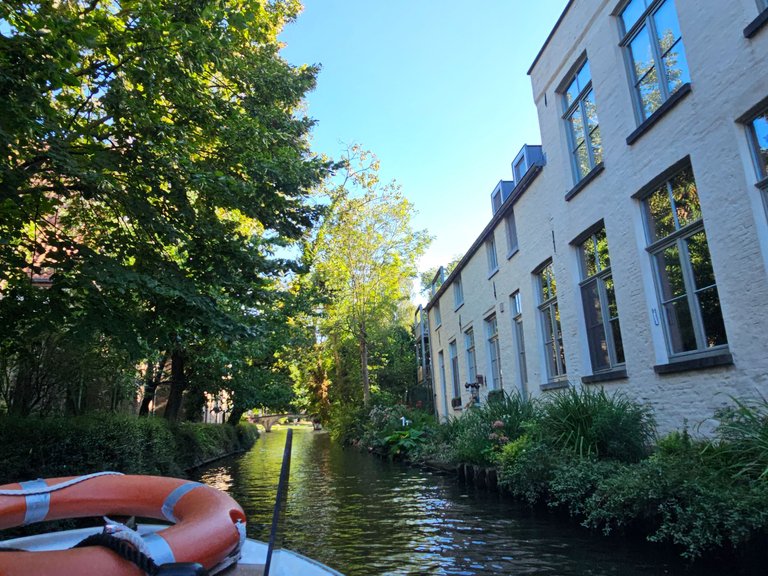
As we crossed this bridge, the Gegijnhofbrug, a small park opened up behind it.
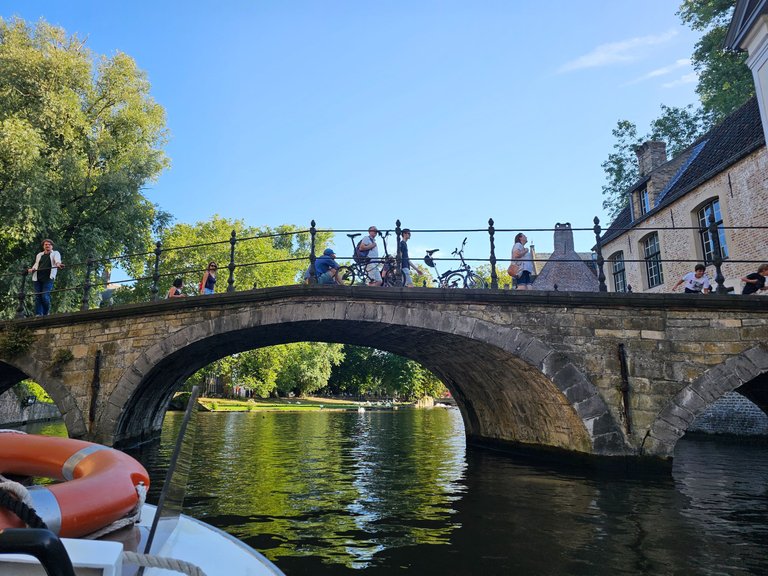
Lots of swans and ducks occupied the banks here. There were no people to be seen on the grass. Here in Bruges they have created little oases for the birds, which are protected from us two-legged friends by a fence. The swans probably noticed this too and clearly felt at home there.
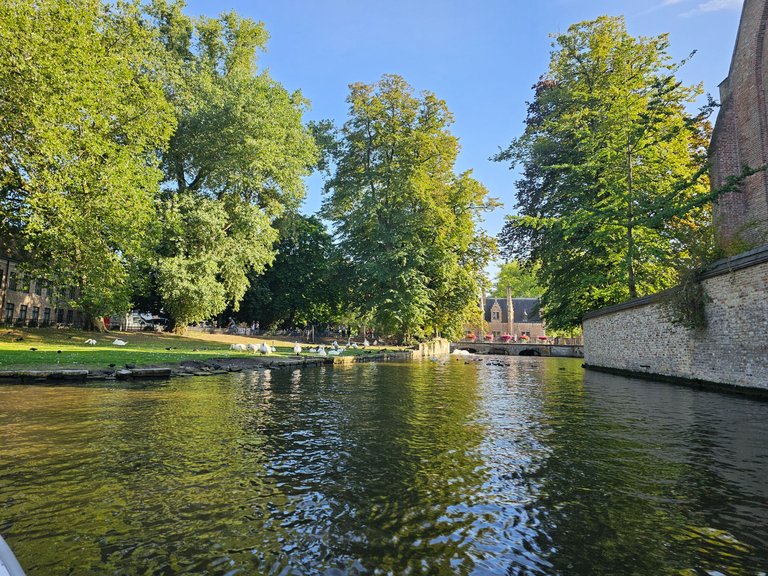
Then we went back again. Here is the Gegijnhofbrug again, only from the other side.
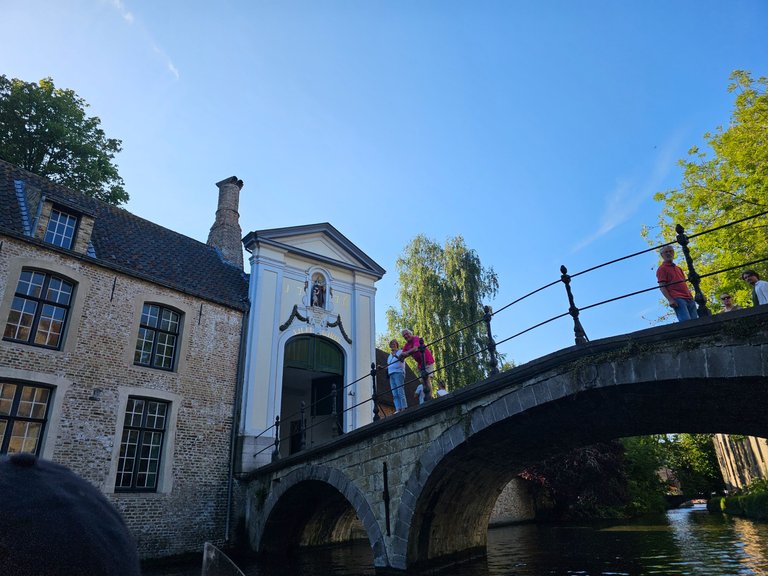
Even though we've driven through here before, we discovered new things about the houses. How nice it must be to be able to have breakfast in the little bay window.
If it weren't for all the tourist boats constantly passing through.
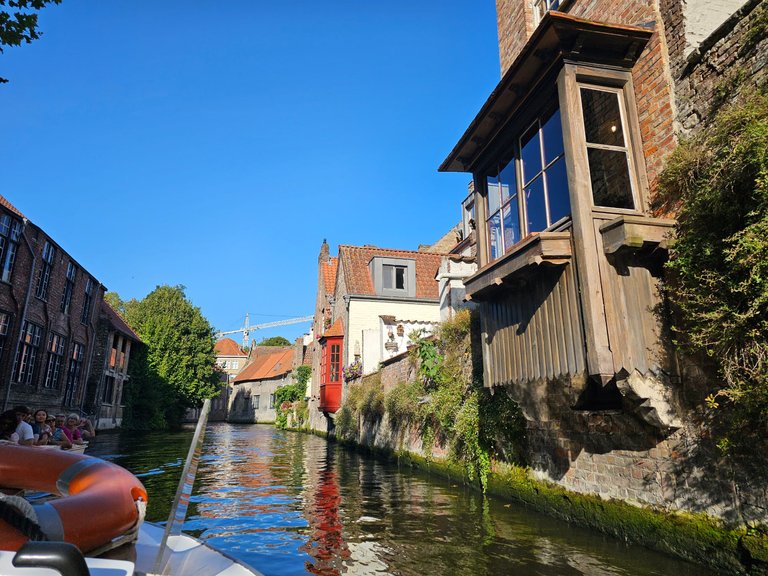
This is probably a kind of kindergarten where you can leave your children for a few hours. They have fun and the parents can take care of other things in peace.
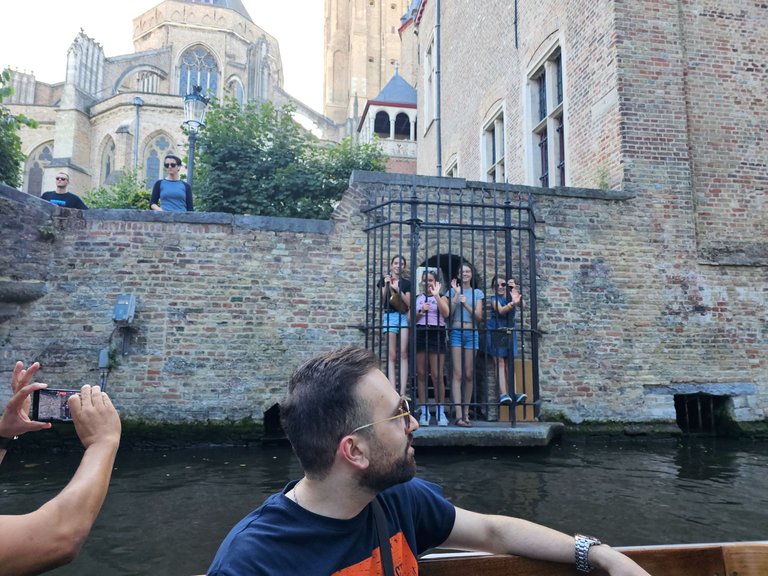
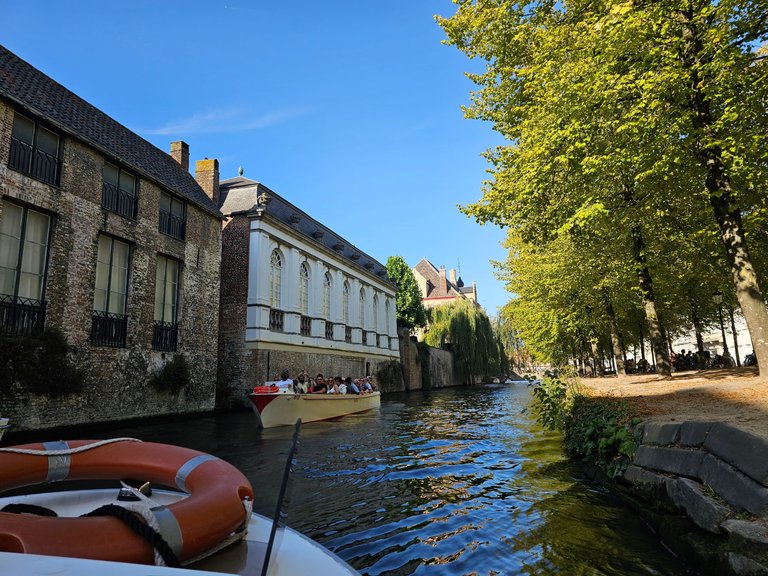
After about 40 minutes, the mooring point was already visible in the background.
What a pity. I could go on like this for a long time.
But it was a really nice trip through Bruges by boat.
So if you ever want to go on vacation in Bruges, you can't avoid a boat trip like this.
You discover lots of little corners that you can easily reach on foot afterwards.
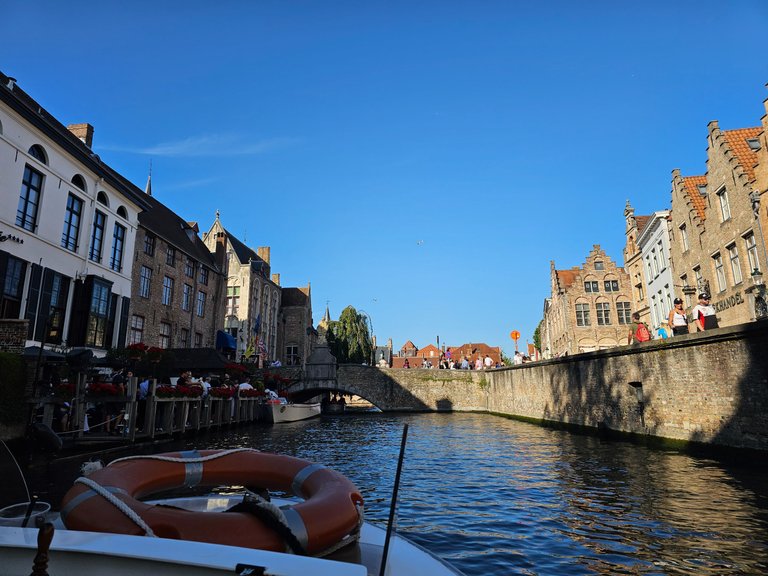

Ich habe schon mal von Brügge berichtet.
Als wir im letzten Sommer dort waren, haben wir am zweiten Tag eine Bootsfahrt gemacht, um uns etwas in der Stadt zu orientieren.
Brügge wird auch "Venedig des Nordens" genannt. Das ist für mich als Augsburger etwas zweifelhaft. Auch wenn diese Stadt eine Menge Brücken hat, konnte ich nicht rausfinden, wie viele es genau sind. Meine Stadt, also Augsburg, wird ebenfalls "Venedig des Nordens" genannt. Wir haben 530 Brückenbauten. Hamburg zählt mit 2500 Brücken als die Stadt mit den meisten Brücken Europas. Venedig hat dagegen gerade mal etwa 400.
Natürlich sagt das nichts über die Schönheit der Brücken aus. Zweifellos sind in Brügge sehr schöne alte Brücken.
Der Fluß, der durch Brügge fließt heißt Reie und die Kanäle die in Brügge fließen sind von ihm abgeleitet.
Die Bootsfahren sind durch die Stadt reglementiert und kosten überall rund das gleiche.
Für etwas 35 Minuten zahlt man pro Person 12 Euro. Wenn ich das mal mit einem Fahrgeschäft auf dem Oktoberfest vergleiche, ist das ein Schnäppchen. Dort kostet eine 40 sekündige Fahrt ca. 10 bis 14 Euro.
Es sind fast immer die gleichen Boote. Kleine Elektro Boote mit Platz für ungefähr 26 Personen.


Solange man noch nicht losgefahren ist, kann man schon mal einen Blick darauf werfen, was so alles auf einen zukommen kann.

Mit dem Wetter hatten wir wirklich Glück an diesem Tag. Es waren keine Wolken zu sehen, und es herrschten angenehme 25 Grad. Für einen Spätsommer durchaus das beste, was einem passieren kann.

Rechts seht ihr ein noch nicht befülltes Boot. So ungefähr sahen alle aus.


Wir hatten einen sehr lässigen Skipper. Während der Fahrt musste ich öfters mal laut Lachen. Ich denke aber, er macht die gleichen Witze bei jedem. Bei ihm hat es sich aber nicht abgedroschen angefühlt. Wenn ich mir vorstelle, dass ich den ganzen Tag Touristen durch die Kanäle schippern müsste, und wohl immer die gleichen Kommentare beantworten muss, wäre ich nicht so gut gelaunt gewesen. Vielleicht war in der Dose Cola, die er getrunken hat, aber auch ein bisschen mehr drin als nur Cola.
Auf jeden Fall war das hier auf dem Bild drunter, unser Kapitän.
Bei den meisten anderen Booten, saßen fast ausschließlich ältere Skipper mit voller Uniform am Steuer. Ich war ganz froh, dass es bei uns etwas lockerer aussah.

Man hat hier schon den Anschein, dass die Häuser kein Hochwasser erwarten. Das ist wohl gut abgesichert.


Von den Kanälen kommt man eigentlich nie an irgendwelche Restaurants ran. Die sind immer von der Strasse aus zu betreten. Trotzdem sind immer mal wieder Schilder zu sehen. Ich denke das ist einfach deshalb, weil fast jeder Tourist einmal mit dem Floß hier durchfährt und sich den nächsten Stopp nach der Tour schon mal merken möchte. Da ist so ein Hinweis auf ein Restaurant schon von Vorteil.


Jedenfalls merkt man schnell, das die Brücken so gut wie immer aus Stein sind.

Auf dem Bild untern wird deutlich, wie fast alle Häuser in Brügge gebaut sind. Klinker als Fassade ist hier wohl Vorschrift.

Dieses Uferstück ist der Gastronomie gewidmet. Hier findet man ein Restaurant nach dem anderen. Wir sind dort nur durchgelaufen, da wir die Touristenrestaurants immer versuchen zu meiden, wenn es geht.
Ein Blick auf die Speisekarte gab uns Recht.
Pasta mit Soße für 25 Euro ist schon mal ne Ansage.


Wie schön solche Häuserreihen vom Wasser aus aussehen. Da ist so ein eiserner Erker wie hier im Bild schon fast störend.



In diesem kleinen Seitenarm des Kanals kann man die Poortersloge sehen. Eins der zahlreichen Kappellen in Brügge.

Diese Brücke heißt Meebrug.


Natürlich machen die Skipper auch Werbung für die Kneipen in der Stadt. Das hier ist die Bourgogne des Flandres. Eine Kneipe mit Brauerei. Ich denke viele auf den Booten gehen danach in eines der angepriesenen Lokale.


Die Liebfrauenkirche ist berühmt für die Kunst die in der Kirche ausgestellt ist.
Unter anderem ist hier die Brügger Madonna von Michelangelo ausgestellt. Leider konnten wir diese nicht sehen.


Das hier ist die Bonifaciusbrücke. Eigentlich sieht sie aus wie jede andere hier.
Die steht in fast jedem Reiseführer über Brügge drin.
Es ist wohl eines der jüngsten Brücken hier, aber auch eines der Romantischsten. Zumindest sagt man das. Wir konnten nicht wirklich erkennen, warum sie romantischer sein soll als die anderen. Aber sicher ist sie schön.



Das ist wohl der schönste Teil der Reise mit dem Boot. Man fühlt sich fast wie im Mittelalter.




Plötzlich tauchte hier eine Art kleiner See auf. Es ist Sint Janskaai. Dort waren ebenfalls ein Lokal mit Tischen im Freien. Sicher ein schöner Ort, den wir aber wegen Zeitmangel nicht besucht haben.


Man merkte, dass plötzlich mehr grün am Ufer war. Es fühlte sich ein bisschen an, als ob man aus dem inneren Kern der Stadt langsam raus fuhr.

Als wir dann diese Brücke, die Gegijnhofbrug, durchquerten, tat sich dahinter ein kleiner Park auf.

Lauter Schwäne und Enten besetzten hier das Ufer. Keine Menschen waren auf dem Rasen zu sehen. Hier in Brügge hat man für die Vögel kleine Oasen geschaffen, die mit einem Zaun vor uns Zweibeinern gesichert sind. Das merkten wohl auch die Schwäne und fühlten sich dort sichtlich wohl.

Danach ging es wieder zurück. Hier ist nochmal die Gegijnhofbrug, nur von der anderen Seite.

Auch wenn wir hier schon einmal durchgefahren sind, entdeckten wir wieder neue Dinge an den Häusern. Wie schön muss es sein, wenn man dort in dem kleinen Erker Frühstücken kann.
Wenn da nicht die ganzen Touristenboote ständig durchfahren würden.

Das hier ist wohl eine Art Kindergarten, wo man seinen Nachwuchs für ein paar Stunden abstellen kann. Die haben Spaß und die Eltern können sich mal in Ruhe um was anderes kümmern.


Nach ungefähr 40 Minuten war im Hintergrund dann auch schon der Anlegepunkt zu sehen.
Sehr schade. Sowas könnte ich noch lange weiter machen.
Aber das war wirklich ein schöner Trip mit dem Boot durch Brügge.
Wer also mal in Brügge Urlaub machen will, wir um so eine Bootsfahrt nicht drum rum kommen.
Man entdeckt viel kleine Ecken, die man danach zu Fuß auch locker erreichen kann.







